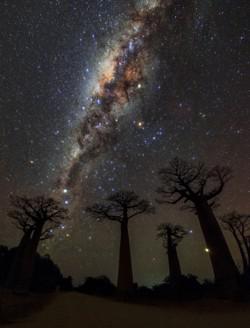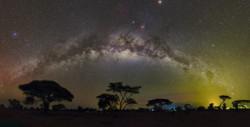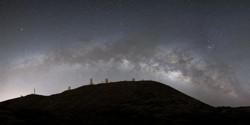Glossary term: Interstellar Extinction
Description: Interstellar extinction is the combined effect of absorption plus scattering of light from astronomical sources by interstellar matter. Interstellar matter is matter that is present in the space between the stars in galaxies and is made up of gas and submicron-sized dust particles. Interstellar dust has a much larger effect on starlight as compared to the gas particles. Huge lanes of dust and gas in the Milky Way can be observed with the naked eye as gaps between the faint glow of millions of stars. Extinction makes observations of regions with lots of gas and dust difficult. Extinction is generally higher at shorter wavelengths making astronomical objects appear redder (reddening). This variation due to wavelength means that astronomers often use longer wavelengths such as infrared or submillimeter light to study dust-enshrouded regions such as star-forming regions.
Related Terms:
- Atmospheric Extinction
- Dust
- Extinction
- Gas
- Infrared Astronomy
- Milky Way
- Star Formation
- Submillimeter Astronomy
See this term in other languages
Term and definition status: This term and its definition have been approved by a research astronomer and a teacher
The OAE Multilingual Glossary is a project of the IAU Office of Astronomy for Education (OAE) in collaboration with the IAU Office of Astronomy Outreach (OAO). The terms and definitions were chosen, written and reviewed by a collective effort from the OAE, the OAE Centers and Nodes, the OAE National Astronomy Education Coordinators (NAECs) and other volunteers. You can find a full list of credits here. All glossary terms and their definitions are released under a Creative Commons CC BY-4.0 license and should be credited to "IAU OAE".
If you notice a factual error in this glossary definition then please get in touch.
Related Media
Drive
Credit: Marcin Zajac/IAU OAE
License: CC-BY-4.0 Creative Commons Attribution 4.0 International (CC BY 4.0) icons
Milky Way over Avenue of Baobabs
Credit: Amirreza Kamkar/IAU OAE
License: CC-BY-4.0 Creative Commons Attribution 4.0 International (CC BY 4.0) icons
Milky Way Arch over Amboseli National Park
Credit: Amirreza Kamkar/IAU OAE
License: CC-BY-4.0 Creative Commons Attribution 4.0 International (CC BY 4.0) icons
Teide Observatory
Credit: Curd-Christian Tengeler/IAU OAE
License: CC-BY-4.0 Creative Commons Attribution 4.0 International (CC BY 4.0) icons
Oregon Coast
Credit: Marcin Zajac/IAU OAE
License: CC-BY-4.0 Creative Commons Attribution 4.0 International (CC BY 4.0) icons













